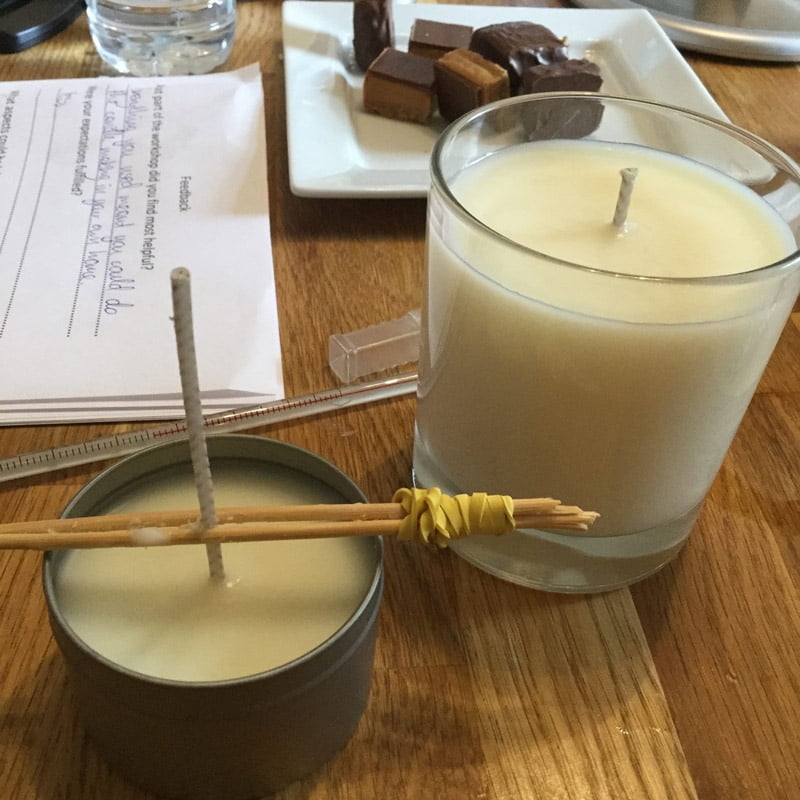Introduction
There are a wide variety of product options you can use to scent candles, depending on your needs. Fragrance oils are the most common option as they are affordable and offer an extensive selection of scents. Essential oils are another popular choice, as these natural scents provide therapeutic benefits as well. Wax tarts and wax melts are also effective since they provide powerful, lasting fragrances that can be added to any oil-based candle. Additionally, potpourri is an attractive option for dried flower petal scenting paired with candle wax. Finally, it’s important to keep in mind that some art supplies like alcohol ink and dye may also be used as a way to create interesting shades and designs in your candles in addition to providing them with a pleasant aroma.
Essential oils
Using essential oils to scent candles can be a great option if you are looking for a natural method, instead of using synthetic fragrances. Pros include that they last longer, evaporate less and provide true aromatherapy benefits, as well as having a wide variety of scents available. Cons include the higher cost compared to synthetic options and budgeting in the cost of the oil(s) when pricing your products for sale.
Best practices for using essential oils to scent candles include not overloading the flame with too much oil, as this can be hazardous. Diluting with other base oils before adding can also help reduce costs in addition to keeping concentrations at safe levels. Additionally, different types of waxes require different amounts, so it’s important to refer to dilution rates specific to your product type whenever possible. Lastly, make sure you use only pure oils, not artificial fragrances or fragrance oils. Artificial fragrances contain solvents and other non-natural elements that are known health risks; fragrance oils do not have any therapeutic benefits, and may both create an unpleasant scent and stain clothes or carpets when spilled on them.
Fragrance oils
Pros: Fragrance oils are the most popular and cost-effective way to scent candles, offering an immense selection of scents. Many fragrances provide a long-lasting and powerful scent throw, making them ideal for larger spaces. Additionally, they’re generally mixed with essential oils to allow your candle to also contain therapeutic properties, helping to improve mental clarity and cognitive ability.
Cons: The intensity of certain fragrance oils can be overwhelming if too much is added in comparison to the wax weight. It’s therefore important you stick to the manufacturer’s guidelines when using these products. It’s also essential to ensure you research compatibility between different candle making supplies such as fragrances and wicks as this can have a huge impact on scent throw and burn time.
Best Practices: When using fragrance oils make sure you pause briefly after adding each fragrance oil until the oil is fully incorporated into the wax mixture before adding more. You should do no longer than 6-8% of your total wax weight as it may lead to poor burning characteristics or adverse reactions in some cases. Always use accurately measured amounts with digital scales when possible for best results and keep accurate records of all fragrances used for future reference. Remember that cured candles retain more sent from fragrance oils than those that are freshly made so working timescales should always be considered too!
Aromatherapy Candles
Using aromatherapy oils to scent candles is a popular way to create ambiance and well-being in a space. When used correctly, these concentrated plant extracts can be an effective tool for enhancing your environment. Aromatherapy oils can fill a room with calming or uplifting scents, help soothe muscle tension, as well as offer many other mental and physical benefits.
When selecting aromatherapy oils to scent candles there are some important considerations to keep in mind. First of all, it important to select the right type of oil for the desired effect ” some may be energizing while others may promoting relaxation. It is also best practice to use only pure therapeutic grade essential oils which have been thoroughly tested for their aroma and purity. Finally, proper dilutions must be followed when adding any type of oil or fragrance to wax media, such as a candle. Blending ratios can vary but typically range from 1%-5% of total liquid weight. In general, higher dilution rates could result in off-flavors or clogging if not done properly.
Besides using aromatherapy essential oil blends for their therapeutic effects there are several other reasons why people opt for creating homemade scented candles. They are relatively easy to make and personally customize with your favorite colors and fragrances. Homemade candles also allow you to explore the properties and effects of various essential oils one would not likely find in store bought containers at much lower cost than buying individual bottles of each variety separately. Ultimately, exploring different methods scenting natural wax based goods allow us greater control over our final product and the enjoyment we take from them; with just little research and guidance we can experience breathtaking results!
Natural Alternatives
When it comes to candle making, what you choose to scent your candles with can be just as crucial as the quality of wax or wick that you use. To ensure that your candles smell fantastic and provide a pleasant burn experience, it is important to consider the benefits of natural ingredient alternatives when looking to scent your creations.
Natural ingredients provide long-lasting scents which are free from synthetic fragrances and toxins. Some popular examples include essential oils such as lavender oil, bergamot or orange oil and even rosemary, if you’re looking for something refreshingly herbal. Popular natural beeswax is an excellent wax choice that brings out the fragrance in many common ingredients used for scenting candles. Coco butter in its purest form is also great for using as a candle wax additive; not only does it improve the aroma and longevity of the candle burn but it also adds additional stiffening benefits while burning. Soy-based waxes are made from renewable resources and have the added benefit of bio-degradability, making them ideal for scenting too! For example, smells such as citrus or floral infusions can be combined with soy waxes for a wonderful result. Similarly, vegetable based waxes are manufactured from non-petroleum sources, providing an eco-friendly way to make beautiful smelling candles with added color pigmentation if some extra finesse is desired!
No matter which type of natural ingredients you opt for when crafting your candles, always remember that high quality ingredients are key in creating products that offer both pleasant aromas and enjoyable burned experience. As long as you experiment with different recipes until one satisfies all your needs ” good luck in finding the best one suited to you!
Soy Wax
When it comes to candle making, soy wax is often the preferred choice of materials over its paraffin counterpart. Soy wax doesn’t just offer superior results in terms of the appearance and burn quality; it provides several benefits when used for scented candles as well.
When using soy wax to make scented candles, some important considerations should be taken into account for best results. Firstly, you will want to select a stable soy-based wax with a good melt point that won’t overheat easily when lit. Secondly, select an appropriate scent or blend of scents that will compliment the material being used and work well with the type of container or shape you are planning on making your candles in. Properly measuring out your ingredients and temperatures are also key components in producing an excellent result!
Using the right amount of fragrance oil is incredibly important; too much can result in smoke and produce an unpleasant burning smell as well as liquify around the wick area, causing further problems during burning. Depending on what type of fragrance or combination you’re using, typically 1 ounce (2 tablespoons) per pound (16 ounces) is used”but this should always be double-checked before beginning!
Finally, keep in mind that not all fragrances work well with soy wax; those containing phenols don’t typically work together very nicely”the exception being concentrated essential oils like lavender that have low levels present in them. Always be sure to read up on compatibility between fragrances and waxes prior to use to ensure safe and successful scenting!
Beeswax
Beeswax is an all-natural wax which is produced by honeybees in the form of tiny scales. Its natural properties are heat resistant, waterproof and airtight, making it the perfect medium to scent candles with. The small size of the beeswax makes it easy to add large quantities of this wax to your candle formula while maintaining a strong scent throw.
One of the best benefits of using beeswax for scented candles is that it produces a long-lasting fragrance that doesn’t dissipate over time. This means that your candle can enjoy its original scent for months and even years! In addition, beeswax emits a soft sheen which works to enhance the visual appearance of your candle, creating a beautiful aura throughout your home. When choosing types of beeswax for your candles, be sure to select one without chemical additives or fragrances as these can interfere with the natural aroma of your essential or fragrance oils.
When incorporating beeswax into your homemade candles however, it’s important to not use more than 25% beeswax within your melted wax mixture; adding too much may cause difficulties when attempting to extinguish and relight certain wicks – such as wooden ones – while encouraging excessive smoke production. It’s also necessary to understand that every type of wax has its own burning characteristics (including beeswax) so it’s always important to keep beeswax separate from other waxes when testing out their burn times and optimal pouring temperatures during production.
Appropriate Scents
When it comes to scents for candles, there are a variety of strong, pleasant smells to choose from. Popular options include floral fragrances like lavender and rose, citrus scents such as grapefruit and orange, earthy aromas like sandalwood and patchouli, herbal notes like eucalyptus and mint, as well as fragrances that combine different elements. Depending on the ambiance you’re hoping to create with your candle, choose accordingly.
It’s important to be aware that some ingredients used in certain fragrances can be hazardous when used around an open flame ” think essential oils versus fragrance oils ” so use caution when shopping for ready-made scented candles or making your own at home. For this reason, it is best to avoid having too much of any flammable components suspended in oil (including citronella oil or tea tree oil) near the wick of a candle flame. In addition to inflammable oils, scents made with phthalate carriers are likely not safe either as these kinds of chemicals have been known to cause irritation and allergic reactions when inhaled.
Troubleshooting
When troubleshooting any issues with candle scenting, there are a few techniques you can use in order to identify the source of the problem.
Check Your Candle Wax: The type of wax you use for your candles can play an important role when it comes to scent retention. Paraffin wax and soy wax are the most popular waxes used for candle making, with both offering various benefits depending on their purposed use. Make sure your wax is well-suited for scenting by researching the recommended candle scents for your chosen method of wax melting.
Inspect Your Essential Oils & Fragrance Oils: If you’re using essential oils or fragrance oils to scent your candles, make sure to inspect them before each use. Essential oils will naturally start to lose their potency over time, so try not to store them longer than two years. Fragrance oils should also be top-notch quality, as low-quality oils may evaporate during burning and not properly infuse the desired scent into your candles.
Monitor Burning Times: There should be proper balance between melting and evaporating during burning times. If your candles’ burning times are too short, there’s likely not enough time for them to burn long enough to properly disperse the desired amounts of fragrance oil or essential oil throughout its surrounding area. Burning times should range from two hours up to five hours per inch Wick diameter, ensuring thatcandles have ample time to thoroughly disperse their fragrance without becoming overly hot or intense in scent throw saturation levels.
Finally: After all else has failed, it may be helpful bring in a friend (or friends) who can help identify problems related specifically scented elements such as focusing ontop notes and base notes. Scented candles require much more side taste than a basic candle shape – sometimes a fresh set of eyes might identify a problem you couldn’t!
Conclusion
When making scented candles, be mindful to use the best-quality materials as these can affect the outcome of your craft. High quality wax can help create clean and even burning candles, while fragrance oils can lend a pleasing aroma. Furthermore, consider investing in wick sustainers and other tools to keep your candles looking neat. Always remember to practice safety when handling hot wax and melting the candle different phases before combining fragrances. Lastly, never forget to cure the candles; this is done by allowing your finished candle project to rest for 24 hours before use or gifting. Following these basic suggestions helps ensure that your scented candles will exude a pleasant and safe scent, creating an enjoyable experience for anyone who uses it.

Welcome to my candle making blog! In this blog, I will be sharing my tips and tricks for making candles. I will also be sharing some of my favorite recipes.





